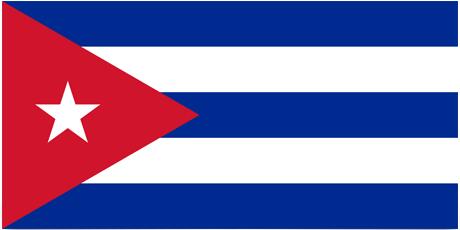Cuba Flag and Meaning
Flag of Cuba

Cuba Flag Meaning
The flag was adopted on May 20, 1902, but the history goes back to 1848. A Venezuelan general named Narciso Lópes designed the flag and used it in an attempt to liberate Cuba from Spanish colonial rule, the attempt failed. That the flag got the look it has, may be due to the fact that part of the liberation movement had its roots in Cuban exiles in the United States, the goal was then to make Cuba one of the US states.
The red triangle, which is a classic Masonic symbol, stands for freedom, equality and brotherhood, the white star is the symbol of independence. The three blue lines represent the country’s three original provinces.
Cuba Overview
| Population | 11.2 million |
| Currency | Cuban Pesos |
| Area | 110,860 km² |
| Capital city | La Habana |
| Population density | 101.0 residents/km² |
| HDI location | 55 |
The Cuban archipelago includes the main island of Cuba, Isla de la Juventud (Youth Island) as well as 1,600 smaller islands and islets. Apart from the southeastern part of the country where the Sierra Maestra mountains lie, the country is characterized by extensive fertile flat areas. Sugarcane plantations cover 60% of the cultivable area – especially in the flat northern regions. The country is extracting its nickel reserves and, furthermore, the Caribbean beaches are utilized in tourism.
The people: Cubans call themselves “African-Latinos” due to the traces of Africa and Europe in the country’s ethnic composition.
Religion: Catholic (39.6%), atheists (6.4%), Protestant (3.3%), and African religions.
Language: Spanish (official)
Political parties: According to the Constitution, the Communist Party of Cuba (PCC) constitutes “the top leadership of society and the state”. The PCC was formed in October 1965 by the Partido Unido de la Revolución Socialista (PURSC, the Unity Party of the Socialist Revolution), which had been formed in 1962 by a restructuring of the Organizaciones Revolucionarias Integradas (ORI, the Unified Revolutionary Organizations). ORI was formed in 1961 by a merger of: Movimiento Revolucionario 26 de julio (M-26, The Revolutionary July 26 Movement), Directorio Revolucionario 13 de marzo (DR-13, The Revolutionary Leadership of March 13), and Partido Socialista Popular (PSP, People’s Socialist Party).
Social organizations: Central de Trabajadores de Cuba (CTC), is the national organization. It has nearly 3 million members, representing 80% of the workforce. In 1988, the Asociación Nacional de Pequeños Agricultores (ANPA), the National Association of Small Farmers, had 167,461 members distributed among 3,500 basic committees. Federación de Mujeres Cubanas (FMC, Cuban Women’s Association) has over 2 million members. The Union de Jovenes Comunistas (UJC, the Union of Youth Communists) has over 1 million members. The Federación Estudiantil Universitaria (FEU, the Association of University Students) and the Federación de Estudiantes de la Enseñanza Media (FEEM, the Association of Middle School Students) together have over ½ million members. The pioneering organization “José Martí” organizes 2 million children and young people. Committees of the Defense of the Revolution (CDR,
Official name: República de Cuba
Administrative subdivision: 14 provinces and 169 municipalities, which are among the special municipality on Isla de la Juventud.
Capital: Ciudad de La Habana, 3,710,000 (2006).
Other important cities: Santiago de Cuba, 534,600 residents; Camagüey, 342,900 residents; Holguín, 305,000 residents; Guantánamo, 264,100 residents; Pinar del Río, 172,300 residents (2000).
Government: Miguel Díaz-Canel is President of the Councils of State and Ministers and elected by the People’s Assembly in April 2018. The People’s Assembly has 609 elected members. The constitution adopted in 1976 established a pyramid structure of representative assemblies from the local to the national level. The electoral mandate can be revoked by the voters at any time.
National Day: January 1 (Revolution Day, 1959). July 26 (National Rebellion Day – Anniversary of the attack on the Moncada Barracks, 1953).
Armed Forces: 105,000 (1995).
Paramilitary forces: 1,369,000 distributed among the Fuerza de Defensa Civil (Civil Defense), Milicia Territorial (Territorial Militia) and Seguridad del Estado (State Security Service).













































